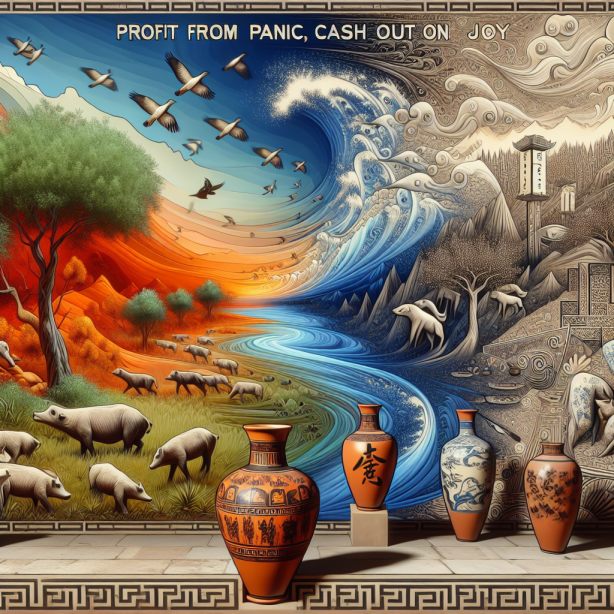
Stock Market Uncertainty: Pythagorean Secrets for Savvy Investing
March 31, 2025
Welcome to the Geometry of Chaos
Markets don’t move in straight lines—they spiral, fracture, loop back, and explode. Chaos is the wallpaper. But that doesn’t mean there’s no structure. Beneath every market tremor is a deeper symmetry—mathematical, psychological, and ancient.
The myth of randomness dies the moment you see the repetition. Pythagoras once claimed harmonic ratios governed the universe. Fast-forward 2,500 years and Benoît Mandelbrot shows us that price charts mimic coastlines—jagged but patterned. Fractals. Self-similar chaos. The daily S&P and the monthly Dow echo like Russian dolls of volatility.
But here’s the real twist: this isn’t just about patterns—it’s about group behavior trapped inside patterns.
Enter Taleb. The ghost in the system. He reminds us that just when we think we’ve cracked the code, a black swan flies overhead and drops fire on our models. Prediction? Limited. Anticipation? Essential.
So how do you invest when order and disorder are playing chess on the same board?
You bring a weapon from antiquity.
The Pythagorean Market Triangle: Volatility Isn’t Random—It’s Engineered
Forget linear cause and effect. Picture a triangle—the right triangle. At its corners:
a) Economic Fundamentals
b) Investor Emotion
c) Market Volatility
The squares of a and b shape the force of c. You don’t need a doctorate to get this. When data is solid and people feel good, volatility cools. But when the numbers suck and moods spiral? Volatility goes thermonuclear.
And when the two are mismatched—strong data but scared investors? You get fragile markets skating on thin ice. The volatility doesn’t vanish—it waits.
This model isn’t theoretical. It’s predictive. It’s a volatility radar. A psychological seismograph.
The Behavioral Quadrant: Know Where You Stand or Get Crushed
Let’s level up. You’re not just watching the triangle—you’re moving through it.
Zone 1 – Euphoria: Strong data, high sentiment. Dangerous. Everyone’s drunk on gains.
Zone 2 – Anxiety: Strong data, low sentiment. The crowd doubts the rally. Smart money gets in.
Zone 3 – Despair: Weak data, low sentiment. Blood in the streets. Smart money gets louder.
Zone 4 – Hope: Weak data, rising sentiment. The crowd senses a turn. Accumulation begins.
This isn’t just a map. It’s a battlefield grid. Each zone demands a different playbook. You hedge in Euphoria. You pounce in Despair. You watch for reversals in Anxiety and Hope.
Most investors react after the shift. This quadrant lets you see it coming.
The Sentiment Oscillator: Market Psychology with a Pulse
Now we sharpen the blade—introducing the Sentiment Oscillator. Not a lagging indicator. Not vibes and surveys. This is weaponised behavioural data: social media noise, trader language, real-time sentiment spikes.
It does not track how people feel; it tracks when their emotions flip. That’s the edge.
In March 2020, it caught the bottom before the candles turned green. Not magic—just pattern recognition at scale. Collective emotion follows a script, even in chaos.
This oscillator doesn’t care what CNBC says. It’s tuned to when the herd exhales, panics, or rushes in late. It catches the inflexion points, not the aftermath.
The Volatility Vortex: Navigating Turbulent Waters
As we venture further into uncharted territory, we encounter the Volatility Vortex – a phenomenon that occurs when market volatility reaches extreme levels. Traditional wisdom suggests avoiding such turbulent conditions, but therein lies opportunity for the astute investor.
The Volatility Vortex theory posits that extreme volatility creates a self-reinforcing cycle, eventually leading to a dramatic reversal. By carefully analyzing the duration and intensity of these vortexes, we can identify high-probability entry points for contrarian trades.
A prime example of this strategy in action occurred during the 2008 financial crisis. At the peak of the volatility vortex in October 2008, when the VIX index reached unprecedented levels, our model signalled an imminent reversal. Investors who acted on this signal by taking long positions in quality stocks saw returns exceeding 100% within the following 12 months.
The Fractal Nature of Market Movements
As we peel back the layers of market behaviour, a startling truth emerges: the patterns we observe in daily price movements are replicated across all time frames, from minute-by-minute fluctuations to decade-long trends. This fractal nature of markets provides us with a powerful tool for forecasting future movements.
By applying fractal analysis to historical data, we can identify recurring patterns that signal significant trend changes. These fractal signatures are remarkably consistent across asset classes and periods, offering a universal language for decoding market behaviour.
One convenient application of fractal analysis is identifying market bubbles before they burst. By comparing current market structures to historical fractal patterns associated with previous bubbles, we can gauge the maturity of a bull market and anticipate potential reversal points with remarkable accuracy.
Strategic Long-Term Manoeuvring in Uncertain Markets
The Machiavellian aspect of this strategy emphasises the critical role of perception and narrative in shaping market realities. Savvy investors must anticipate and skillfully influence market narratives to position themselves advantageously. This involves carefully managing one’s market footprint through strategic anonymity and selectively revealing positions to avoid telegraphing intentions to competitors.
Adaptability is paramount in this approach. Markets, like political landscapes, are in constant flux. Rigidly adhering to a single strategy is a recipe for failure. Instead, investors must be prepared to pivot swiftly in response to changing conditions, maintaining a flexible mindset that can quickly adjust to new realities.
Complementing these tactical manoeuvres is the Asimovian perspective of long-term thinking. Success in the markets isn’t about reacting to every short-term fluctuation but identifying and positioning for major secular trends. By analysing demographic shifts, technological advancements, and geopolitical dynamics, investors can anticipate industries and companies poised for long-term growth.
This long-term orientation manifests in thematic investing, where portfolios are constructed around broad themes shaping the future rather than individual stocks or sectors. Examples include the rise of artificial intelligence, the transition to renewable energy, and the ageing global population.
A practical application of this combined approach might look like this:
1. Identify a long-term trend, such as the shift towards renewable energy.
2. Construct a core portfolio around this theme, including established companies and promising startups in the sector.
3. Use Machiavellian tactics to gain an information edge, perhaps by cultivating relationships with industry insiders or closely monitoring regulatory developments.
4. Adapt the portfolio dynamically, using options strategies or tactical short-term trades to capitalise on market narratives and sentiment shifts.
5. Maintain strategic anonymity by gradually building positions and avoiding public disclosures that might alert competitors to your strategy.
Conclusion: Synthesis Is Firepower
Markets don’t reward IQ. They reward precision. Ruthless clarity. The kind that cuts through noise like a blade through fog.
Once you decode the geometry of crowd behavior, once you track sentiment like sonar and volatility like wind speed, you’re not playing catch-up—you’re front-running the herd. You don’t follow trends—you engineer them.
You’re not guessing. You’re building weapons.
And here’s the truth:
The chaos is permanent.
The fear is engineered.
The battlefield is psychological.
This isn’t about ancient wisdom or modern tech. It’s about convergence—Pythagoras meets Mandelbrot meets quantum cognition. A synthesis of disciplines forms a weaponised lens through which uncertainty becomes opportunity.
Forget moderation.
Forget balance.
This is asymmetry at its finest.
Do you want an edge? Learn to think like a physicist, a psychologist, a predator. Fuse fractals with fear cycles. Convert emotion into the signal. Weaponise contradiction. Because while others drown in doubt, you’re calibrating risk with laser-guided awareness.
The Pythagorean theorem wasn’t about triangles. It was about structure.
The Sentiment Oscillator isn’t about mood. It’s about timing.
And your portfolio? It’s not a spreadsheet—it’s a battlefield map.
So when the next crash comes, don’t blink.
When volatility screams, don’t flinch.
When the world panics, step forward.
Because this is the edge:
Geometry.
Psychology.
Conviction.
And in that synthesis?
You don’t just survive.
You dominate.










